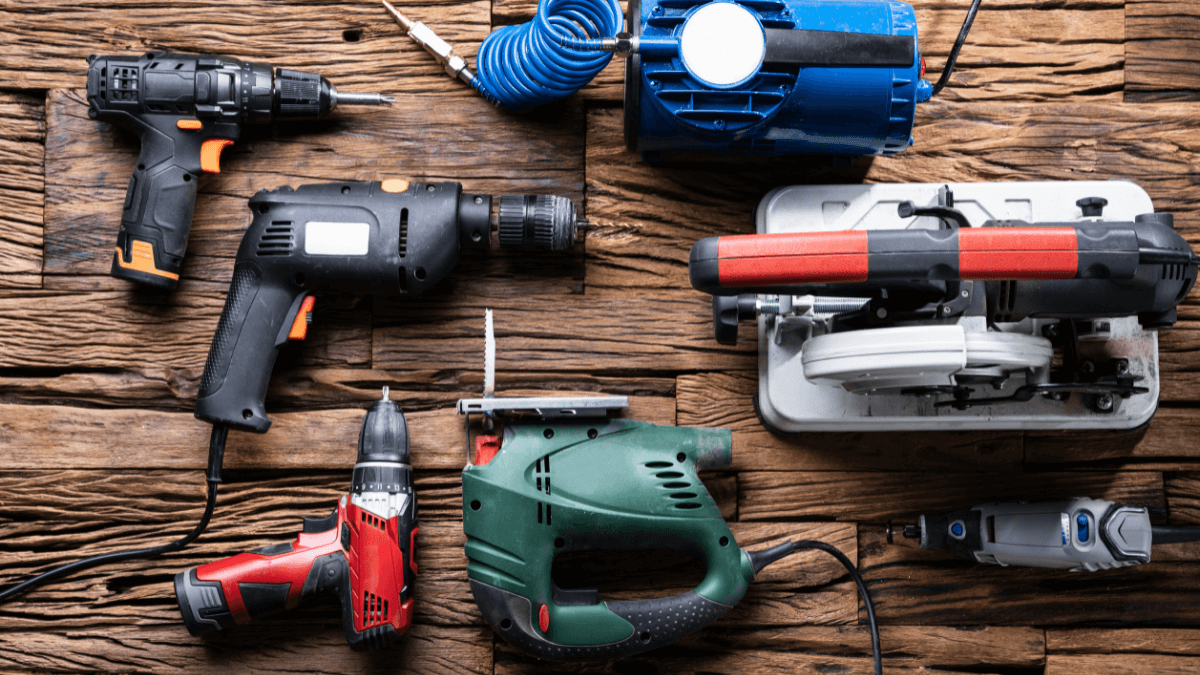Personal protective equipment (PPE) saves lives. Construction companies know this, construction workers know it—we all know it.
So, why does the Occupational Safety and Health Administration (OSHA) still find so many PPE-related violations when they conduct site inspections?
Usually, the problem lies either with the companies, which neglect to provide the necessary PPE and the related training, or the employee that ignores instructions.
As a construction worker, you should follow the rules regarding protective equipment in construction to keep yourself and others out of danger. Let’s learn how you can do just that!
In this article...
Always Wear the PPE Mandated by Your Employer
PPE is mandated in the construction industry for a good reason: the safety of those on the worksite.
OSHA has firm rules in place for workers and employers alike with the ultimate goal of protecting field workers from different hazards.
As a construction worker, you must wear the PPE your employer has provided.
Of course, if there is a valid reason why you cannot wear a particular piece, you should bring your concerns up to your supervisor so you can find another solution together.
For example, people who wear turbans for religious reasons may be exempt from wearing head protection at work. But, this is something you should communicate with your company instead of deciding on your own.
OSHA mandates construction companies to give their employees specific PPE for free because of how high the risks are in this industry.
If your employer doesn’t provide you with at least the mandatory PPE and training, think twice before going out into the field for them. It is your right to demand this type of protection.
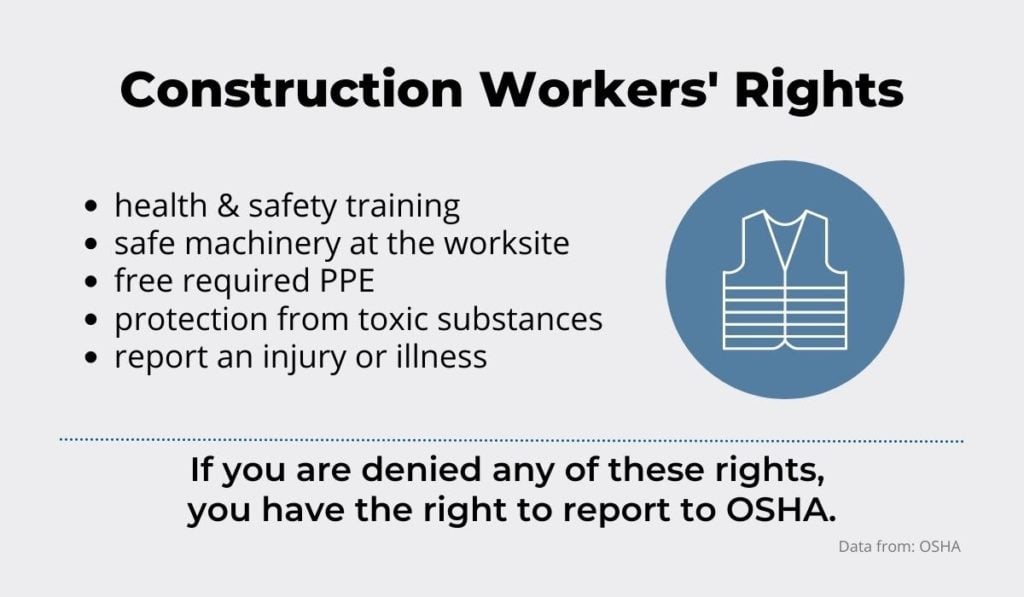
However, some construction workers are afraid of retaliation. That’s what happened to a Pennsylvania worker who asked for proper PPE twice after getting hurt at the job site.
The company believed this employee reported them to OSHA, so they fired him, which wasn’t legal.
“Employers who retaliate against workers for raising valid safety concerns are breaking the law and creating an unsafe work environment for all of their workers,” says Michael Rivera, OSHA’s regional administrator.
Because of this move, the employer now faces a federal lawsuit by the US Labor Department, who are trying to fine them $200,000 for breaking violations.
On top of that, the Labor Department wants the company to reinstate the employee and pay for his past and future losses due to his firing.
Therefore, your employer will work on your request instead of firing you. If they do end up letting you go, you have OSHA to fall back on to protect your rights.
Insist on PPE That Suits You Properly
This point might not be as straightforward as the others, but it’s just as important: poorly-fitting PPE is considered a safety hazard.
Most protective equipment is made for the average-sized man. Therefore, most women and men who are above or below what’s considered the average size are usually stuck wearing ill-fitting PPE at the construction site.
Because of this, women are at a higher risk of injury than their male peers.
The problem is actually widespread, according to AXIS Network, whose research found that more than two-thirds of female construction workers got coveralls that didn’t fit. Half of them had the same issue with outerwear or jackets.
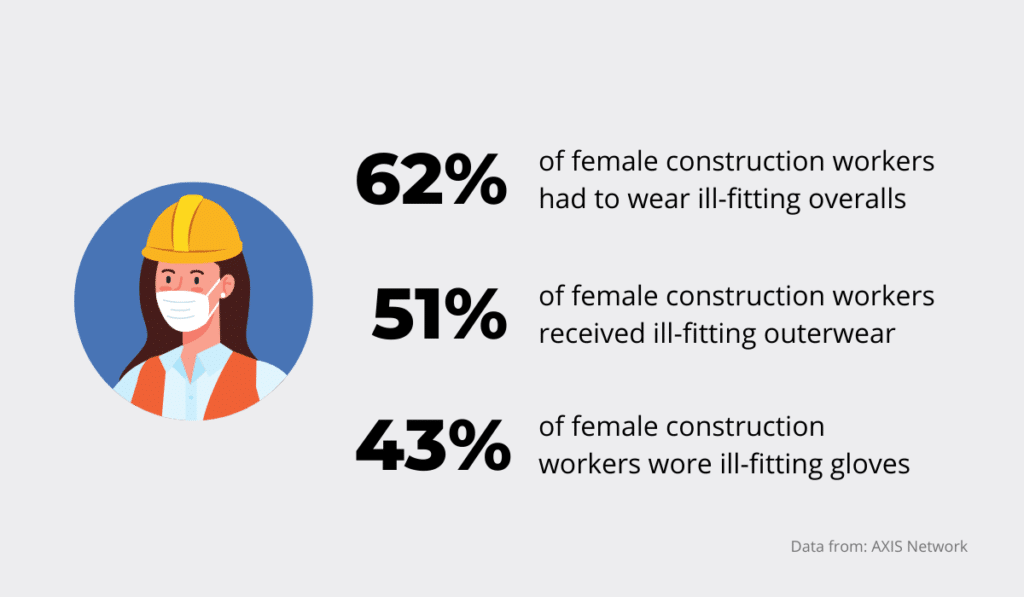
Therefore, this is not a problem of the select few, but the large majority of women in the industry, as well as a good portion of men, which puts them all at risk.
“There is no one size fits all when it comes to PPE,” the International Safety Equipment Association (ISEA) stated when they addressed the problem of ill-fitting protective equipment and called for OSHA to handle and prioritize it.
The problem goes beyond gender and continues to exist because there are no final OSHA regulations, so many employers aren’t as focused on sizing as they should be.
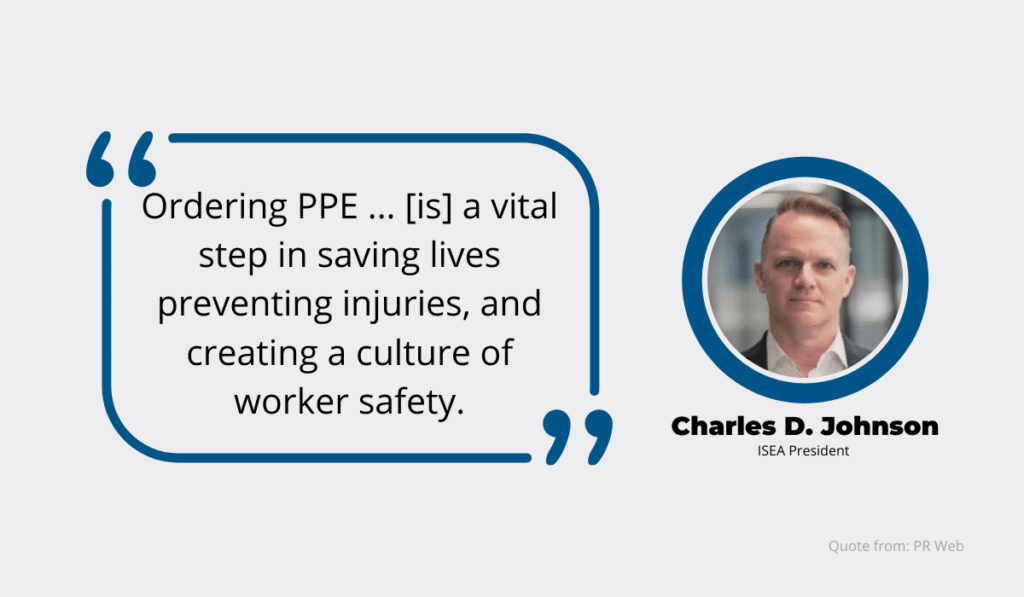
As the ISEA president Charles D. Johnson stresses, getting the right PPE can help you avoid injuries and hazards, as well as promote your company’s culture of worker safety.
A part of this culture is your ability to bring up your concerns without the fear of retaliation.
So, when you receive PPE that doesn’t fit you properly, talk to the company and arrange for them to give you something that suits you better. Otherwise, you’re putting yourself and those around you at risk.
Wear PPE That Is Suited to the Job
The PPE you wear should change depending on the job you’re currently doing.
In fact, OSHA has made it obligatory for construction companies to give you PPE that is appropriate for the job you’re performing and that covers the risks associated with that specific job site.
In other words, you can’t wear the same type of shoes, for example, if you’re working at a building site where there’s a risk of falling objects or one with dangerous chemicals.
These jobs entail different risks, and a single pair of shoes can’t be suitable for both.
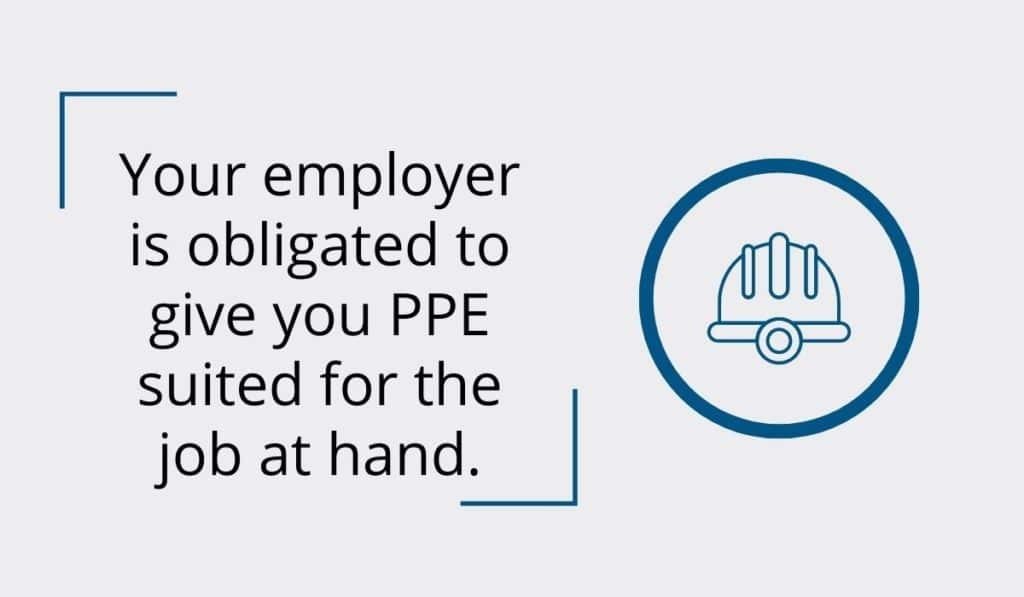
In the case of the former, you need quality steel-toe shoes to protect your feet from any objects that might fall and crush them. In the latter case, you need shoes that won’t absorb the toxic chemicals and let them get in contact with your skin.
Employers should assess these hazards before deciding what PPE works best for the given environment.
If your company doesn’t do this and lets you have one set of protection for different seasons, terrains, and job types, you have the right to voice your concerns and report the issue to OSHA if they don’t address it.
When you keep wearing PPE that’s not suited for the nature of the job, you’re risking serious injury or even death.
Sadly, this happened to a construction worker performing maintenance in a trench without appropriate PPE. After a fire, he sustained deadly injuries. OSHA determined that proper equipment and training could have prevented the incident.
So, when you realize the PPE you have is not suitable for the task you’re performing, speak up!
Keep Your PPE in Top Shape
When you receive the PPE that is suitable for the tasks you’re assigned to, always keep it in good shape.
Otherwise, it might malfunction or not do its job correctly, meaning that you will be in danger despite wearing protective equipment.
According to OSHA, employees are responsible for cleaning and maintaining PPE. Therefore, don’t expect your employer to clean your gear for you. Think of it as a mandatory daily task that ensures protection from the hazards that come with the job.
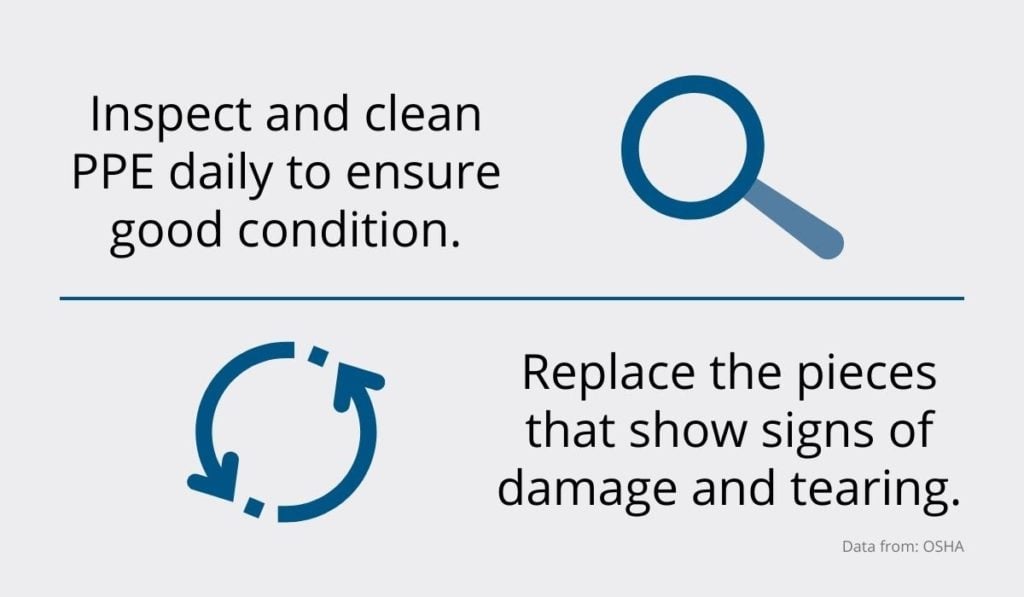
Of course, your employer should provide sufficient PPE training, including teaching you how to care for this type of equipment properly. A big part of caring for PPE is conducting daily checks to ensure it is in good working condition.
Here’s a little reminder on how to inspect and care for some of the most popular pieces of PPE:
| PPE | Inspection | Care |
|---|---|---|
Head protection | Check for tears, holes, and other damages. Check for signs of exposure to chemicals, UV light, and other radiation. | Never paint, drill holes, or apply labels to hard hats. Clean the surface. |
| Hand and arm protection | Check before every use for signs of tearing or damage. Fill gloves with water and roll the cuff towards the fingers to find even the smallest leaks. | Clean the reusable pieces of equipment, discard the disposable types. |
Footwear and leg protection | Check for tears and damage daily. Check shoes and protective leggings for wear and tear. Check soles of shoes for pieces of metal or similar embedded objects. | Clean any type of dirt off the shoes. Care for the shoes according to the manufacturer’s manuals (example below). |
Here’s an example of how a professional cleans and conditions their waterproof work boots!
As you can see, it’s essential to remove the laces and brush the shoes to get out all the debris and dirt you can. Then, rinse and wash the shoes to get off the remaining dirt.
After that, let the shoes dry and apply a product to protect your shoes.
However, there are cases where no cleaning or care will help get your PPE back in good condition. For example, hard hats should always be replaced after an impact, even if there’s no visible damage.
If your PPE comes with accessories or suspensions and gets damaged, you can simply replace these parts and keep the original equipment if it’s in good condition.
Of course, PPE doesn’t last forever, which means you’ll have to ask for a replacement piece when yours gets damaged or is simply worn out.
Return Your PPE to Its Designated Place
After each use, you should return your protective gear to a safe storing place.
Of course, you have to ensure that you store it under the perfect conditions. Let’s say your work requires you to drive a truck around the worksite and wear a hard hat at all times.
After your shift, you shouldn’t leave your hat in your vehicle and go home.
OSHA advises never to leave equipment such as hard hats in direct sunlight, like on the dashboard of a vehicle. Extreme heat and sunlight can cause significant damage to it.
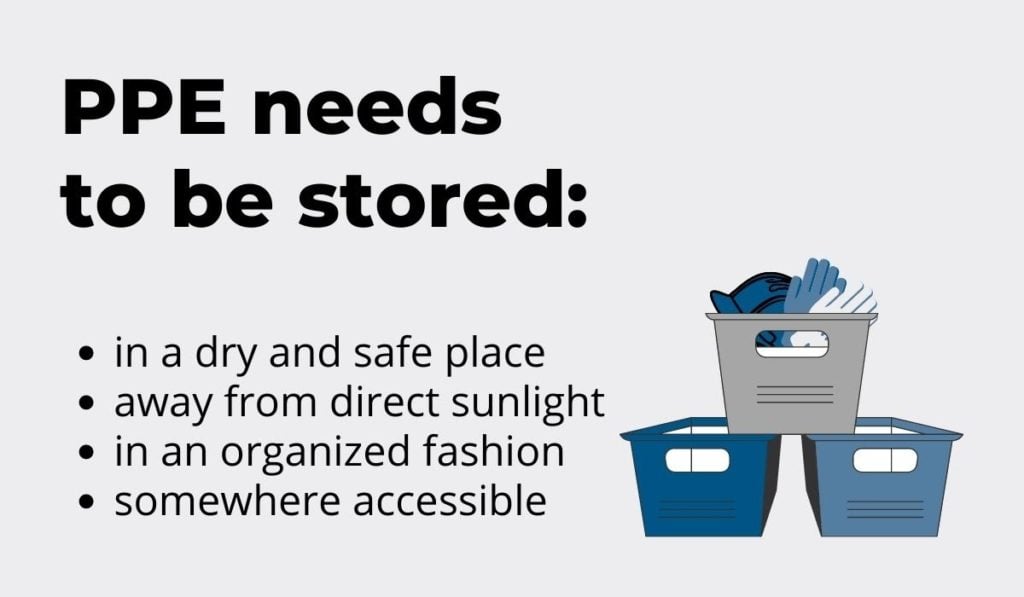
Instead, each workplace should have an area designated specifically for the safe storing of equipment, including PPE. This is where employees put away their PPE and get replacement assets if there is an issue.
Therefore, the objects must be stored safely, while still remaining easily accessible to the workers. They need to be in a dry, sanitary space to avoid any damage to the equipment in question.
When you’re out in the field, you’ll most likely return your equipment to a storage container used as a makeshift storage room. Since most quality containers are wind and waterproof, good storing conditions are guaranteed.
If you find an issue with the storage or think the conditions are compromised because of outside factors, mention it to your employer. These factors could make a dent in the quality of PPE your team uses.
Don’t Hesitate to Ask For Instructions
If you’re unsure how to use or clean PPE properly, ask your employer to give you instructions.
After all, as implied earlier, it is mandatory for them to provide training and teach people how to use this life-saving equipment correctly. The training should also be in a language that you can understand, as per OSHA’s instructions.
Since your employer should do their best to protect you at the workplace, they also need to teach you how to maintain the PPE you receive.
Unfortunately, some companies skip the training part, especially in the case of temporary workers who usually don’t speak the same language as the rest of the crew.
This type of reckless behavior puts employees at an even greater risk of injury as they are simply given equipment but never shown how to use it, how to check if it functions properly, and how to care for it.

A terrifying example of insufficient training leading to a deadly accident occurred in 2015.
A Spanish-speaking temporary worker fell into a hopper after a sugar factory bridge collapsed. OSHA found different possible causes for this incident, including the lack of health and safety training for both the worker and supervisor.
In other words, had they been trained properly, the accident could have been avoided, and the worker would still be alive today.
Most PPE comes with instructions from the manufacturer, so this is something you can always check for additional information.
Some companies opt to keep such crucial data in the cloud, adding the pdf file as an attachment to the equipment’s main page. In other words, you have to scan the QR code of the asset in question.
When you do, your phone will redirect you to the asset’s page in the system, where you will find a link to the instructions on how to use it.

Even if your company doesn’t have asset tracking software, you should still have access to the manufacturer’s manuals or instructions your company has created to help you use PPE.
That way, you’ll always have a reminder on how to use, care for, and store the PPE at hand safely.
Conclusion
PPE is essential for your safety on the construction site, which is why OSHA puts so much importance on it and heavily fines those who do not follow their regulations.
The rules you, as a construction worker, should follow are simple.
You should always wear mandatory PPE. Said equipment should fit you and be suitable for the job at hand.
Next, make sure to care for and maintain the equipment as needed, which includes regularly returning your PPE to the storage area, to prevent unnecessary exposure to the elements.
Finally, in case of any confusion, ask for instructions.
OSHA decided on these rules to ensure that each worker knows how to accurately use and care for PPE. That way, the equipment stays in a well-enough condition to perform its function.
Since the employer must inspect the workplace for potential hazards, as well as distribute the necessary PPE, and provide workers with training, always feel free to voice your concerns regarding any of these points.





